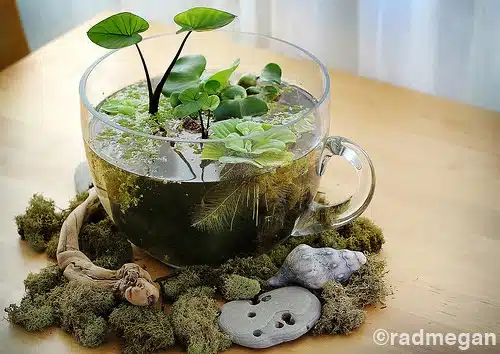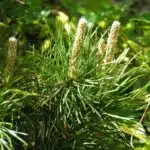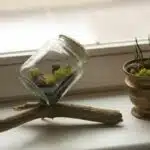Indoor water gardens are a great way to add natural beauty and tranquility to any living space. Not only do they provide a calming atmosphere, but they also have numerous benefits for your health and well-being. If you’re interested in creating your own indoor water garden, there are several things you need to consider before getting started.
Firstly, it’s important to choose the right plants for your indoor water garden. Certain plants thrive in aquatic environments while others may struggle, so it’s important to do your research beforehand. Secondly, you’ll need to decide on the type of container or vessel you want to use for your water garden. There are many options available, from small tabletop containers to larger floor-standing fountains. With proper planning and care, an indoor water garden can be a beautiful addition to any home or office space. In this article, we will discuss how to make an indoor water garden step by step and provide tips on how to maintain it for years of enjoyment.
Benefits Of Indoor Water Gardens
Indoor water gardens offer a myriad of health benefits that make them a worthwhile investment. For starters, indoor water gardens have been shown to purify the air by removing toxins and pollutants, resulting in cleaner air for breathing. This is especially beneficial for individuals with respiratory issues such as asthma or allergies. Additionally, the sound of trickling water from an indoor water garden can create a calming effect that reduces stress levels and promotes relaxation.
Moreover, indoor water gardens serve as natural humidifiers, adding moisture to the air in dry climates or during winter months when heating systems can cause dryness in the home. This is essential for maintaining healthy skin and respiratory systems. Indoor water gardens also offer mental health benefits by promoting feelings of tranquility and well-being, which can improve mood and reduce anxiety.
Therefore, if you are looking for an effective way to improve your overall health and well-being while adding a touch of beauty to your home, investing in an indoor water garden is definitely worth considering. The next step is choosing the right location for your new addition to ensure it thrives in its environment.
Choosing The Right Location
Indoor water gardens are a beautiful addition to any home or office. Not only do they provide visual appeal, but they also offer numerous benefits such as improving air quality and reducing stress. However, before you start setting up your indoor water garden, it’s important to consider the location of the space carefully.
When it comes to choosing the right location for your indoor water garden, there are several factors to consider. First and foremost, you need to assess the space requirements of your plants. Some aquatic plants require more room than others, so it’s essential to choose a location that can accommodate their growth. Additionally, you need to ensure that the location you choose has adequate access to electricity and a water source.
Location considerations also extend beyond just space requirements. You need to think about other factors such as lighting and temperature needs. For example, some aquatic plants thrive in bright light while others prefer more shade. Similarly, some plants can tolerate cooler temperatures while others require warmer conditions. Taking these factors into account will help ensure that your indoor water garden thrives and provides all its intended benefits.
Assessing light and temperature needs is an essential step in setting up an indoor water garden that thrives over time. By considering these factors along with space requirements during the planning phase, you can create an environment that supports your aquatic plants’ growth and health. In the next section, we’ll take a closer look at how to assess these needs so that you can make informed decisions about where to set up your indoor water garden.
Assessing Light And Temperature Needs
To ensure that your indoor water garden thrives, it is important to assess the light and temperature needs of the plants you choose. When it comes to light, most indoor water plants require bright indirect light, which means placing them near a window that receives filtered or indirect sunlight. Direct sunlight can scorch the leaves and cause damage to the plant. If natural light is not available, grow lights can be used as an alternative.
Temperature is another crucial factor in maintaining a healthy indoor water garden. Most aquatic plants thrive in temperatures between 70-80°F (21-27°C). However, some plants may require cooler temperatures, so it’s important to research the specific needs of each plant before making your selection. Additionally, fluctuations in temperature can affect water quality and lead to algae growth or other issues.
Adjusting water flow and monitoring water quality are also essential aspects of caring for an indoor water garden. Water flow should be adjusted based on the needs of each plant species, as some may require more or less movement than others. It’s important to regularly monitor pH levels and nutrient levels in the water to ensure that they are within appropriate ranges for your chosen plants. This can be done using test kits or by taking samples of the water for analysis at a local gardening center.
As you continue on your journey towards creating an indoor water garden, keep in mind that assessing light and temperature needs is just one aspect of caring for your plants. In the next section, we will explore different types of plants that are suitable for indoor water gardens and how to select the right ones for your space.
Types Of Plants For Indoor Water Gardens
Aquatic plants are those which live in water and are adapted to surviving with their roots submerged in water. Examples of aquatic plants include water lilies, irises, and papyrus. Bog plants, on the other hand, are those which require the soil to be constantly moist and are adapted to living partially submerged in water. Examples of bog plants include various species of sedges, rushes, and grasses. Submerged plants are those which require the soil to be completely submerged in water and are adapted to living entirely underwater. Examples of submerged plants are hornwort, water milfoil, and anacharis.
Aquatic Plants
Aquatic plants add a unique and calming touch to indoor water gardens. These plants are specifically adapted to grow in water, making them ideal for indoor ponds or fountains. When selecting aquatic plants for your indoor water garden, it is important to consider their care requirements. Some popular choices include the water lily, lotus, and papyrus. All of these plants require full sun exposure and regular fertilization.
Aquatic plant care is essential for maintaining a healthy water garden ecosystem. Proper care includes regular pruning and removal of dead leaves or flowers, as well as monitoring the pH balance of the water. Most aquatic plants also require periodic repotting to provide them with fresh soil and nutrients. In addition to caring for your aquatic plants, selecting fish that are compatible with your water garden is also important. Fish can help keep the water clean by eating algae and other debris, but they must be selected carefully to avoid overcrowding or aggressive behavior.
Overall, incorporating aquatic plants into your indoor water garden can bring a sense of tranquility and natural beauty into your home. With proper care and maintenance, these plants can thrive in their watery environment while providing a stunning visual display for you and your guests to enjoy. Remember to select the right types of plants for your space and regularly monitor their health to ensure a thriving ecosystem in your indoor water garden.
Bog Plants
When it comes to selecting the types of plants for indoor water gardens, bog plants are a great addition. These plants grow in shallow water and wet soil, making them ideal for planting at the edges of indoor ponds or fountains. Bog plants come in a wide range of colors and textures, from grasses to flowering perennials. They also have unique growing techniques that require specific care.
To successfully grow bog plants in an indoor water garden, it is important to choose the right type of soil mixture. A mix of peat moss, sand, and perlite is recommended to create a nutrient-rich environment that will support healthy root growth. In addition to proper soil, pest control is also essential for maintaining the health of your bog plants. Regular inspection and removal of any pests or diseased leaves can prevent further damage.
Overall, incorporating bog plants into your indoor water garden can add depth and texture to your overall design. With proper care and maintenance, these unique plants can thrive in their watery environment while providing a stunning visual display for you and your guests to enjoy. Remember to regularly monitor their health and adjust their growing conditions as needed to ensure optimal growth and beauty.
Submerged Plants
When it comes to selecting the types of plants for indoor water gardens, submerged plants are another excellent option. These plants are fully submerged in water and are known for their unique ability to oxygenate the water through their leaves. Submerged plants come in a variety of colors and shapes, from delicate ferns to vibrant greenery. They also offer numerous benefits to an indoor water garden, including improved water quality and reduced algae growth.
To successfully grow submerged plants in your indoor water garden, it is essential to choose the right type of plant selection and maintenance techniques. It is important to select plants that are compatible with your specific water conditions, such as light levels and temperature. Additionally, regular maintenance is crucial for ensuring the health of your submerged plants. This includes monitoring nutrient levels, pruning damaged leaves, and preventing overcrowding.
Overall, incorporating submerged plants into your indoor water garden can provide numerous benefits while also adding beauty and texture to your overall design. With proper care and attention, these unique underwater plants can thrive while improving the health of your entire ecosystem. Remember to regularly assess their growth and adjust their growing conditions as needed to ensure optimal results.
Soil And Fertilizer Requirements
Now that we know the best plants for indoor water gardens, it is crucial to understand their nutrient requirements. Proper soil and fertilizer are essential for the growth and health of your plants. The aquatic plants in your garden require a specific type of soil that contains nutrients such as nitrogen, potassium, and phosphorus.
Using a high-quality organic aquatic plant fertilizer is the best way to ensure you meet their nutrient requirements. It is essential to keep in mind that too much fertilizer can harm your plants; therefore, follow the instructions carefully. Additionally, some aquatic plants do not require any fertilizers at all.
In conclusion, understanding the nutrient requirements of your indoor water garden’s plants is crucial for their overall success. Ensuring you use the correct soil and fertilizer will help keep them healthy and thriving. In our next section, we’ll discuss selecting the perfect container for your indoor water garden without sacrificing style or functionality.
Selecting The Perfect Container
When selecting a container for an indoor water garden, size is an important consideration, as it will determine how many aquatic plants can be placed in the garden.
The material of the container is also critical, as it must be watertight and durable enough to hold water for extended periods of time.
Additionally, it is important to choose a container that has adequate drainage holes, as these are necessary to prevent the build-up of water and the associated risk of root rot.
When determining the size of the container, it is important to consider the number and type of aquatic plants that will be included in the garden.
Various materials can be used to make containers for indoor water gardens, such as ceramic, plastic, and even hypertufa.
Containers used for indoor water gardens should have a minimum of three drainage holes, as this will allow excess water to escape and help prevent root rot.
Size
As an indoor gardening specialist, it is important to consider the size of the container when creating a miniature water garden. The size of the container determines the amount of space available for plants and aquatic life. When selecting a container, it is essential to consider the available space in your home and the type of plants you wish to include in your water garden. Maximizing space is crucial for creating an efficient and visually appealing indoor water garden.
The ideal size for an indoor water garden container depends on the desired outcome. If you prefer a small and simple water garden, a compact container may suffice. However, if you want to create an elaborate miniature ecosystem with multiple plants and fish species, a larger container will be necessary. A good rule of thumb is to choose a container that allows at least 2-3 gallons of water per plant.
When choosing a container for your indoor water garden, it is also important to consider its shape and depth. Shallow containers are suitable for small plants like mosses and ferns, while deeper containers can accommodate taller plants like lilies or lotuses. Additionally, round or oval-shaped containers provide more surface area for aquatic life compared to rectangular or square-shaped ones.
In summary, selecting the perfect container involves considering its size, shape, and depth. Maximizing space is key when creating miniature water gardens indoors. By choosing a container that can accommodate your desired plants and aquatic life while fitting within your available space limits, you can create an efficient and visually appealing indoor water garden that brings tranquility into your home without taking up too much room or effort on maintenance.
Material
When it comes to creating an indoor water garden, selecting the perfect container is crucial. Aside from considering its size and shape, the material of the container is also a key factor to take into account. The material used for the container has a significant impact on the overall look and feel of your water garden. As an indoor gardening specialist, I highly recommend using materials that are not only functional but also sustainable.
One of the most popular materials for indoor water garden containers is glass. Glass containers provide a sleek and modern look that fits well in any home decor style. They also allow you to see your aquatic life and plants clearly, adding more visual interest to your DIY project. However, glass containers can be fragile and may require extra care during maintenance.
Another popular option is ceramic or clay pots. These materials come in various shapes, sizes, and colors, giving you more options to choose from when creating your miniature water garden. Ceramic or clay pots are durable and can retain moisture for longer periods compared to other materials. They can also keep the temperature of the water inside stable, which is essential for some aquatic species.
Lastly, if you want a more eco-friendly option for your indoor water garden container, consider using recycled plastic or metal containers instead of buying new ones. Not only do they save resources by reducing waste, but they are also budget-friendly alternatives. Using sustainable materials in your indoor gardening projects not only benefits the environment but also promotes sustainable living practices that can benefit future generations.
In conclusion, selecting the right material for your indoor water garden container requires careful consideration of both aesthetic and practical aspects. As an indoor gardening specialist with a passion for sustainable living practices, I highly recommend choosing materials that not only look good but are eco-friendly as well. Whether it’s glass, ceramic or clay pots or recycled plastic or metal containers – there’s no shortage of options when it comes to finding the perfect material for your DIY project!
Drainage Holes
When it comes to selecting the perfect container for your indoor water garden, one crucial factor to consider is drainage holes. These holes are essential for proper water circulation and preventing overwatering, which can lead to root rot and other issues. As an indoor gardening specialist, I highly recommend that you choose a container with proper drainage holes or DIY drainage solutions.
One of the common mistakes that beginners make in creating an indoor water garden is choosing a container without drainage holes. This mistake can cause stagnation of water, leading to the growth of harmful bacteria and algae that can harm your aquatic life and plants. If you have decided on a container without pre-drilled holes, make sure to drill them yourself before planting.
Another option for those who prefer not to drill their containers is to use DIY drainage solutions such as adding pebbles or gravel at the bottom of the container before adding soil or placing a layer of activated charcoal on top of the pebbles. These methods help create space for water to flow freely while keeping your plants’ roots healthy and promoting good bacteria growth. In conclusion, selecting the perfect container with proper drainage holes or implementing DIY drainage solutions is essential for maintaining a thriving indoor water garden.
How To Add Water And Fill The Container
Adding water to your indoor water garden is a crucial step in the setup process. Before adding water to your container, ensure that it is clean and free of any debris or dust particles. Start by filling the container with fresh water at room temperature. If you are using tap water, let it sit for 24 hours before adding it to the container. This will allow any chlorine or other chemicals to evaporate, ensuring better water quality for your plants.
When adding water to your indoor water garden, take into consideration the placement of your plants. Make sure that the roots of each plant are submerged in the water but not sitting in stagnant areas. To ensure proper circulation, consider using a small fountain or pump to move the water around the container. This will also help oxygenate the water for healthy plant growth.
Maintaining good quality water is essential for successful indoor gardening. Water quality can be affected by factors such as temperature, pH levels and nutrient content. Testing kits are available to monitor these factors and make necessary adjustments accordingly. Regularly changing out old or stagnant water and replacing it with fresh clean water will also contribute to maintaining good quality water for your plants. In the subsequent section, we will discuss how choosing the right source of water plays an important role in ensuring good quality for your indoor garden.
Choosing The Right Water Source
Water is the lifeblood of indoor water gardening, and choosing the right water source is crucial to the success of your project. Just like how a healthy body needs clean blood, your water garden needs a clean source of water to thrive. One anecdote that illustrates this point is that of an aquarium owner who used tap water without considering water chemistry. The result was disastrous – his fish died due to toxic levels of chlorine and other chemicals in his tap water.
To prevent such a scenario, it is essential to consider the quality of your water source before starting your indoor water garden. Water filtration is one way to ensure you have clean, healthy water for your plants and aquatic creatures. There are many types of filters available in the market today that can remove impurities like chlorine, heavy metals, and harmful bacteria from tap or well water. Investing in a good quality filter will go a long way in ensuring the health and longevity of your indoor garden.
Water chemistry is another important factor to consider when choosing the right water source for your indoor garden. Different plants require different pH levels and mineral content in their water to thrive. You may need to adjust these parameters depending on the type of plants you choose for your garden. Using distilled or rainwater may be necessary if you have particularly sensitive plants that are picky about their environment.
With an understanding of how critical it is to choose the right water source for an indoor garden, we can now move onto adding stones, pebbles, and decorative items that will enhance its beauty while also providing practical benefits such as drainage and root anchoring.
Adding Stones, Pebbles, And Decorative Items
Adding Stones, Pebbles, and Decorative Items
Creative decoration ideas are essential to any indoor water garden. Adding stones and pebbles can enhance the beauty of your garden by giving it a natural look. You can also add decorative items such as small figurines or aquatic plants like moss balls to create interest and variety. When choosing stones, make sure they are not too large or too small for your container. Smooth river stones work best as they do not scratch the glass.
DIY stone and pebble arrangements can be an excellent way to personalize your indoor water garden. You can use different types of stones such as lava rocks or colored glass beads to create patterns or designs. Pebble mosaics can also be created by arranging them in a specific pattern, such as a spiral or geometric shape. Adding contrasting colors of pebbles will help highlight the design.
Incorporating decorative items into your indoor water garden can make it more visually appealing. You could consider adding fairy lights around the edge of the container to create ambiance at night-time. Alternatively, you could add floating candles to give off a soft glow during an evening gathering with friends and family.
Maintenance and care tips for your indoor water garden are essential for keeping it healthy and beautiful.
Maintenance And Care Tips
The maintenance and care of an indoor water garden is essential to the health and longevity of the plants and aquatic animals living within it. One important factor to consider is water quality. It is necessary to monitor the pH level, hardness, and temperature of the water regularly. Testing kits are available at local pet stores or online retailers. Poor water quality can result in plant death or damage, as well as cause stress for fish or other aquatic creatures.
Another aspect to keep in mind when caring for an indoor water garden is pest control. Insects such as spider mites or aphids can infest plants and harm them. A natural remedy for pest control is introducing beneficial insects like ladybugs or lacewings into the ecosystem. Additionally, neem oil or insecticidal soap can be used to eliminate harmful pests while keeping the environment safe.
To make it easy for you to maintain your indoor water garden, we have created a simple table that outlines some basic maintenance tasks you should perform on a regular basis:
| Maintenance Task | Frequency |
|---|---|
| Water change | Weekly |
| Pruning dead leaves | As needed |
| Fertilizing plants | Monthly |
| Cleaning filter | Bi-Weekly |
By adhering to this schedule, you can ensure that your indoor water garden stays healthy and beautiful year-round. By keeping up with regular maintenance tasks like these, you will enjoy a thriving ecosystem that brings joy and serenity into your home.
Moving on from maintaining your indoor water garden, we shift our focus onto cleaning it thoroughly. A clean environment ensures good health for all living beings within it, including those in your indoor water garden. To keep your ecosystem clean, follow our next set of guidelines closely.
Cleaning Your Water Garden
- Algae is a common issue in indoor water gardens and can be removed through regular maintenance, as well as through the use of algaecides and UV clarifiers.
- Cleaning the tank is essential for maintaining a healthy water garden and should be done by removing debris, performing water changes and vacuuming the substrate.
- Biological filtration can also help to reduce the risk of algae outbreaks by removing excess nutrients from the water and providing an ideal habitat for beneficial bacteria.
- Regular testing of water parameters is also recommended to ensure proper water quality and to identify any potential issues before they become a problem.
Removing Algae
As an indoor water garden expert, one of the biggest challenges that gardeners face is the issue of algae growth in their water gardens. Algae not only affects the aesthetic appeal of your garden but also harms the health of aquatic plants and animals. If left unchecked, it can cause serious damage to your indoor water garden. Therefore, it is essential to take some preventive measures to keep algae at bay.
One of the easiest algae prevention techniques is to maintain proper water quality. Algae thrives in stagnant water that has high levels of nutrients like phosphorus and nitrogen. Hence, it is crucial to filter and circulate your garden’s water regularly using a pump or aerator. Additionally, you can reduce the amount of organic matter by removing dead leaves or debris from your pond regularly. By doing so, you are creating an environment that is less favorable for algae growth.
In case you still find algae in your indoor water garden, there are natural algae remedies you can use instead of chemical treatments. One such method involves adding barley straw to your pond’s filter system. The straw contains chemicals that inhibit the growth of algae without harming other aquatic life forms. Another effective natural remedy is adding floating plants like duckweed and water hyacinth; these plants absorb excess nutrients from the water while preventing sunlight from reaching deep into the pond – a condition that promotes algal growth. With these natural solutions, you can keep your indoor water garden clean and healthy with minimal effort!
Cleaning The Tank
Maintaining the cleanliness of your indoor water garden is crucial to keep it healthy and thriving. One essential aspect of this is cleaning the tank regularly. Algae growth, debris accumulation, and other organic matter can build up in the tank over time, leading to an unhealthy environment for aquatic plants and animals. As an indoor water garden expert, I recommend incorporating regular tank cleaning into your garden maintenance routine.
One effective way to clean your water garden tank is by using DIY cleaning solutions made from natural ingredients like vinegar or lemon juice. These solutions are gentle yet effective in removing stubborn stains or algae buildup without harming your plants or fish. You can also use specialized cleaning tools like algae scrapers or siphons to remove debris from hard-to-reach areas in the tank.
In addition to regular cleaning, you should also monitor the water quality of your indoor water garden regularly. Testing kits are readily available in most gardening stores and can help you detect any imbalances or contaminants in the water that may harm your aquatic life. By keeping a clean and healthy environment for your indoor water garden, you can enjoy its beauty and benefits for years to come!
Pruning And Trimming Your Plants
After cleaning your water garden, the next step is to focus on pruning and trimming your plants. Pruning techniques are necessary for maintaining the overall health and appearance of your indoor water garden. It involves removing dead or damaged plant parts, controlling the growth direction of your plants, and ensuring proper sunlight penetration.
Watering frequency is a vital aspect of indoor water gardening. It is essential to maintain consistent watering habits to prevent under or overwatering your plants. The watering frequency depends on various factors such as the type of plants in your garden, temperature, humidity level, and size of the container. Typically, watering once or twice a week is sufficient for most indoor water gardens.
To ensure healthy growth and longevity of your plants, you need to follow specific guidelines while pruning or trimming them. Here are some important tips that you can keep in mind:
- Always use clean and sharp gardening shears.
- Trim off stems at an angle to prevent water from collecting on top.
- Cut back up to one-third of the plant’s length at a time.
- Dispose of any diseased or dead plant parts immediately.
By following these guidelines, you can enjoy an aesthetically pleasing indoor water garden that is full of life and vitality. In the next section, we will discuss how to prevent algae growth in your water garden.
Preventing Algae Growth
- Lighting is a key factor in controlling algae growth in an indoor water garden as it will limit the amount of photosynthesis that occurs.
- To ensure that algae growth is kept to a minimum, light should not be left on for more than 12 hours a day.
- Monitoring the amount of nutrients in the water is another way to prevent algae growth as it helps to keep the water balanced.
- Regularly testing the water to check for the presence of nitrates, phosphates, and other nutrients can help to ensure that the water garden is kept in optimal condition.
Control Lighting
To prevent algae growth in an indoor water garden, controlling lighting is a crucial factor. Automated timers are an excellent investment to regulate the amount of light your plants receive. They make sure that your plants get enough light for photosynthesis without overexposure to light that encourages algae growth. This way, you can ensure that your plants are healthy and free from unwanted green gunk.
Natural light sources are also necessary for a successful indoor water garden. Consider placing your garden near a window that receives plenty of sunlight throughout the day. However, be mindful not to expose your plants directly to the sun’s harsh rays, as it can damage them. If natural lighting isn’t optimal in your space, consider using LED grow lights or fluorescent bulbs specifically designed for indoor plant growth.
It’s essential to monitor and adjust the lighting conditions in the indoor water garden regularly. Ensure that all areas of the tank receive adequate light exposure while keeping it balanced with dark periods when necessary. By doing so, you can prevent algae from thriving and keep your plants healthy and flourishing all year round!
Monitor Nutrients
To ensure the health and longevity of your indoor water garden, it’s essential to monitor nutrient levels regularly. Testing nutrient levels in your water garden is crucial since it helps you understand the specific needs of your plants. By doing so, you can adjust the nutrients in the water accordingly, preventing algae growth and keeping your plants healthy.
To test nutrient levels, purchasing a testing kit designed for aquariums or hydroponic systems is an excellent investment. These kits measure various factors such as pH levels, nitrate and phosphate levels that affect your plants’ growth. After testing the nutrient levels in your water garden, adjust them according to the specific requirements of each plant species.
Adjusting nutrient levels will help prevent algae growth by ensuring that your plants receive everything they need without overfeeding them. Overfeeding encourages algae growth by providing excess nutrients for it to thrive on. By monitoring and adjusting nutrient levels regularly, you can keep your indoor water garden healthy and free from unwanted green gunk.
In conclusion, monitoring and adjusting nutrient levels are crucial steps to prevent algae growth in an indoor water garden. Testing nutrient levels and adjusting them accordingly will ensure that your plants receive everything they need while avoiding overfeeding that would encourage algae growth. With these tips in mind, you can maintain a beautiful and healthy indoor water garden all year round!
Troubleshooting Common Issues
Common solutions to the most frequently occurring issues with indoor water gardens can be easily remedied with a few troubleshooting techniques. One of the most common problems that many indoor gardeners face is algae growth in their water tanks. This can be resolved by reducing the amount of light that reaches the water surface, ensuring proper filtration, and adding aquatic plants that compete with algae for nutrients.
Another issue that may arise is over or under watering of plants leading to root rot or dehydration respectively. The key to preventing these problems is to maintain a consistent watering schedule and pay attention to the soil moisture levels. You can also consider using a moisture meter to ensure your plants are receiving adequate hydration.
Lastly, maintaining proper humidity levels in your indoor space is essential for healthy plant growth. Low humidity levels can cause leaves to dry out and become brittle, while high humidity levels can lead to fungal growth on leaves and stems. To combat this problem, you can use a humidifier or place trays of water near your plants to increase humidity levels.
By implementing these common solutions and troubleshooting techniques, you can successfully maintain a thriving indoor water garden that provides both visual appeal and a peaceful atmosphere in your home. In the next section, we will discuss how you can fully enjoy the tranquility of your indoor water garden.
Enjoying The Tranquility Of Your Indoor Water Garden
A tranquil indoor water garden is not only a beautiful addition to your home decor but also offers several meditation benefits. The sound of flowing water in the background helps create a peaceful environment, which aids in improving concentration and reducing stress levels. Moreover, indoor water gardens are an excellent way to bring the outdoors inside while maintaining a serene ambiance.
If you’re looking for stress relief techniques, creating an indoor water garden is an effective way to achieve this goal. With its calming effect, the sound of moving water can significantly reduce anxiety and promote relaxation. In addition, spending time taking care of your plants can be therapeutic and help you unwind after a long day at work.
To make the most out of your indoor water garden, here are some tips that will help you create a space that promotes tranquility:
- Choose plants that are easy to maintain and thrive in water gardens such as Peace Lilies or Lucky Bamboo.
- Use natural materials such as stone or wood for planters and decorative elements.
- Add lighting fixtures that provide soft illumination to highlight the beauty of your plants without being too bright.
- Incorporate seating options near your indoor water garden so that you have space to relax and enjoy the peaceful atmosphere.
Creating an indoor water garden is more than just planting some greens; it is an opportunity to transform your living space into a peaceful sanctuary where you can escape from daily stressors. So why wait? Create your own tranquil retreat today!
Conclusion
Indoor water gardens are an excellent addition to any home as they bring tranquility, beauty, and a sense of calmness to your living space. The benefits of indoor water gardens extend beyond their aesthetic appeal. They also help purify the air by removing toxins and increasing humidity levels.
When choosing the right location for your indoor water garden, consider factors such as access to natural light, temperature regulation, and proximity to electrical outlets. It is essential to assess the plants’ light and temperature needs to ensure optimal growth conditions. Some popular plant choices for indoor water gardens include peace lilies, spider plants, and lucky bamboo.
Soil requirements vary depending on the type of plant you choose for your indoor water garden. Fertilizer is also essential for promoting healthy plant growth. Pruning and trimming your plants regularly will prevent overgrowth and maintain their shape. Algae growth can be prevented by keeping the water clean and adding oxygenating plants such as hornwort or anacharis.
If you encounter any issues with your indoor water garden, such as yellowing leaves or pests, troubleshooting solutions are available. Ultimately, creating an indoor water garden allows you to enjoy the calming ambiance that nature provides in your own home.
In conclusion, creating an indoor water garden is a rewarding experience that enhances both physical and mental wellbeing. The process requires attention to detail but yields long-lasting beauty and tranquility in return. As an expert in indoor gardening, I encourage everyone to try creating their own indoor water garden today!
Image Credits
- “INDOOR TABLETOP WATER GARDEN” by CHARMERS•*´¨`♥ (featured)





























